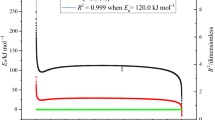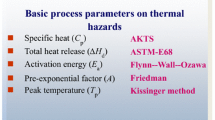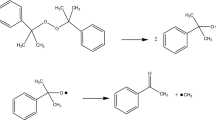Abstract
2,2′-Azobis[2-(2-imidazolin-2-yl) propane] dihydrochloride (AIBI) is a class of initiators that share water-soluble features, which was widely employed in the chemical polymerization industry. The merits of AIBI are that it can conduct smooth, stable, and controllable decomposition reaction and initiate polymerization efficiently at low temperature and concentration. Unfortunately, due to the high formation enthalpy and through a large amount of gas release, AIBI has high-potential thermal hazards. Therefore, the thermal behavior of the whole decomposition process is analyzed through series of simultaneous thermogravimetric analyzer and differential scanning calorimetry tests coupled with the advanced thermal investigation. It is found that AIBI would rapidly decompose and abruptly release an enormous amount of heat in the range of 170 to 180 °C, but with only 10% mass loss in this period. These thermal parameters can be used to describe the thermal stability of AIBI, thus effectively preventing the thermal hazard and loss of control of AIBI in the process of production, transportation, and storage.








Similar content being viewed by others
Abbreviations
- \(\alpha\) :
-
Conversion degree (mass%)
- A :
-
Pre-exponential factor (s−1)
- \(\beta\) :
-
Heating rate (K min−1)
- E a :
-
Apparent activation energy (kJ mol−1)
- \(E_{\alpha \to 0}\) :
-
Limit of kinetic parameter at \(\alpha \to 0\) (kJ mol−1)
- Q p :
-
Peak power of reaction (W g−1)
- R :
-
Universal gas constant 8.314 (J mol−1 K−1)
- R 2 :
-
Fitting degree
- T onset :
-
Onset decomposition temperature (°C)
- T peak :
-
Peak decomposition temperature (°C)
- ΔH d :
-
Heat release of decomposition
References
Sheppard CS, Kamath VR. The selection and use of free radical initiators. Polym Eng Sci. 1979;19:597–606.
Zuo W, Li J, Zhang Y, Li Q, Jia S, He Z. Multi-factor impact mechanism on combustion efficiency of a hydrogen-fueled micro-cylindrical combustor. Int J Hydrogen Energy. 2020;45:2319–30.
Li Q, Zuo W, Zhang Y, Li J, He Z. Effects of rectangular rib on exergy efficiency of a hydrogen-fueled micro combustor. Int J Hydrogen Energy. 2020;45:10155–63.
Nesvadba P. Radical polymerization in industry. Encyclopedia of Polymer Science and Technology. Wiley Online Library. Hoboken: Wiley; 2012.
Klein JA, Mros GR. Characterization and safe handling of reactive initiator solutions. Process Saf Prog. 2006;25:303–10.
Liu J, Yang X, Wang X, Hu L. Recent research progress on the synthesis and application of water soluble azo initiators. Chem Reagents. 2011;4.
Wahl RR, Madison S, DePinto R, Shay B. Mechanistic studies on the decomposition of water soluble azo-radical-initiators. J Chem Soc Perkin Trans. 1998;2:2009–18.
Kurian PV, Chengara A, Atkins JM. Multifunctional azo initiators for free radical polymerizations: uses thereof. Google Patents; 2012.
Dinh LN, Sun TC, McLean W. Temperature-dependent kinetic prediction for reactions described by isothermal mathematics. J Phys Chem A. 2016;120:7617–23.
Starink MJ. The determination of activation energy from linear heating rate experiments: a comparison of the accuracy of isoconversion methods. Thermochim Acta. 2003;404:163–76.
Criado J, Sánchez-Jiménez P, Pérez-Maqueda L. Critical study of the isoconversional methods of kinetic analysis. J Therm Anal Calorim. 2008;92:199–203.
Kurian P V, Atkins JM, Morris JD, Ward WJ. Multifunctional azo initiators for free radical polymerizations: methods of preparation. Google Patents; 2012.
Cheikhalard T, Tighzert L, Pascault JP. Thermal decomposition of some azo initiators. Influence of chemical structure. Die Angew Makromol Chemie. 1998;256:49–59.
Guo S, Wan W, Chen C, Chen WH. Thermal decomposition kinetic evaluation and its thermal hazards prediction of AIBN. J Therm Anal Calorim. 2013;113:1169–76.
Li XR, Wang XL, Koseki H. Study on thermal decomposition characteristics of AIBN. J Hazard Mater. 2008;159:13–8.
Idage BB, Vernekar SP, Ghatge ND. Decomposition rate studies of azo initiators in solution. J Polym Sci Polym Chem Ed. 1983;21:2145–55.
Dumas J-P, Gibout S, Cézac P, Franquet E. New theoretical determination of latent heats from DSC curves. Thermochim Acta. 2018;670:92–106.
**-Hua S, Shou-**ang L, Zhan-Hui S. Study on thermal risk evaluation of reactive substance. China Saf Sci J. 2003;13:44–7.
Liu SH, Shu CM. Advanced technology of thermal decomposition for AMBN and ABVN by DSC and VSP2. J Therm Anal Calorim. 2015;121:533–40.
Liu SH, Lin WC, Hou HY, Shu CM. Comprehensive runaway kinetic analysis and validation of three azo compounds using calorimetric approach and simulation. J Loss Prev Process Ind. 2017;49:970–82.
Zhang C-X, Lu G-B, Chen L-P, Chen W-H, Peng M-J, Lv J-Y. Two decoupling methods for non-isothermal DSC results of AIBN decomposition. J Hazard Mater. 2015;285:61–8.
Blaine RL, Kissinger HE. Homer Kissinger and the Kissinger equation. Thermochim Acta. 2012;540:1–6.
Cai J, Chen Y. Iterative linear integral isoconversional method: theory and application. Bioresour Technol. 2012;103:309–12.
Ng W-L. Thermal decomposition in the solid state. Aust J Chem. 1975;28:1169–78.
Vyazovkin SV, Lesnikovich AI. Practical application of isoconversional methods. Thermochim Acta. 1992;203:177–85.
Zhu J, ** S, Yu Y, Zhang C, Li L, Chen S, et al. Evaluation of thermal hazards and thermo-kinetic parameters of N, N′-dinitro-4, 4′-azo-bis (1, 2, 4-triazolone) (DNZTO). Thermochim Acta. 2016;623:58–64.
Acknowledgements
The authors would like to express their sincere thanks to the Anhui University of Science and Technology in China under contract number QN201613 as well as to the Anhui Province Education Department, Natural Sciences Key Fund, China (Grant No. KJ2017A078).
Author information
Authors and Affiliations
Corresponding author
Additional information
Publisher's Note
Springer Nature remains neutral with regard to jurisdictional claims in published maps and institutional affiliations.
Rights and permissions
About this article
Cite this article
Liu, SH., Wu, T., Lu, YM. et al. Particular thermal behavior of 2,2′-azobis[2-(2-imidazolin-2-yl)propane] dihydrochloride using DSC and STA. J Therm Anal Calorim 144, 343–349 (2021). https://doi.org/10.1007/s10973-020-10053-x
Received:
Accepted:
Published:
Issue Date:
DOI: https://doi.org/10.1007/s10973-020-10053-x




